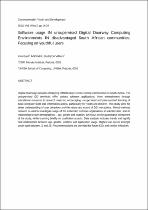 ResearchSpace
ResearchSpace
Software usage in unsupervised digital doorway computing environments in disadvantaged South African communities: Focusing on youthful users
JavaScript is disabled for your browser. Some features of this site may not work without it.
- ResearchSpace
- →
- Research Publications/Outputs
- →
- Journal Articles
- →
- View Item
| dc.contributor.author |
Gush, Kim L

|
|
| dc.contributor.author |
De Villiers, MR

|
|
| dc.date.accessioned | 2013-05-27T13:47:41Z | |
| dc.date.available | 2013-05-27T13:47:41Z | |
| dc.date.issued | 2011 | |
| dc.identifier.citation | Gush, K.L. and De Villiers, M.R. 2011. Software usage in unsupervised digital doorway computing environments in disadvantaged South African communities: Focusing on youthful users. Commonwealth Youth and Development, vol. 9(2), pp 14-34 | en_US |
| dc.identifier.issn | 1727-7140 | |
| dc.identifier.uri | http://www.sabinet.co.za/abstracts/cydev/cydev_v9_n2_a3.html | |
| dc.identifier.uri | http://hdl.handle.net/10204/6752 | |
| dc.description | Copyright: 2011 Commonwealth Youth and Development . This is an ABSTRACT ONLY. The definitive version is published in Commonwealth Youth and Development, vol. 9(2), pp 14-34 | en_US |
| dc.description.abstract | Digital Doorways provide computing infrastructure in low-income communities in South Africa. The unsupervised DD terminals offer various software applications, from entertainment through educational resources to research material, encouraging unsupervised and peer-assisted learning of basic computer skills and information access, particularly for youth and children. This study aims for better understanding of user behaviour and the nature and extent of DD interactions. Mixed-methods research is used to investigate usage of the embedded software applications at selected sites, and its relationship to user demographics – age, gender and location. We focus on the quantitative component of the study, while touching briefl y on qualitative aspects. Data analysis indicates trends and signifi cant relationships between age, gender, location, and application usage. Highest use occurs amongst youth aged between 10 and 25. Recommendations are provided for future DDs and similar initiatives. | en_US |
| dc.language.iso | en | en_US |
| dc.publisher | Commonwealth Youth and Development | en_US |
| dc.relation.ispartofseries | Workflow;10578 | |
| dc.subject | Child-computer interaction | en_US |
| dc.subject | Community informatics | en_US |
| dc.subject | Computer literacy | en_US |
| dc.subject | Software usage | en_US |
| dc.subject | Digital Doorways | en_US |
| dc.subject | ICT in education | en_US |
| dc.title | Software usage in unsupervised digital doorway computing environments in disadvantaged South African communities: Focusing on youthful users | en_US |
| dc.type | Article | en_US |
| dc.identifier.apacitation | Gush, K. L., & De Villiers, M. (2011). Software usage in unsupervised digital doorway computing environments in disadvantaged South African communities: Focusing on youthful users. http://hdl.handle.net/10204/6752 | en_ZA |
| dc.identifier.chicagocitation | Gush, Kim L, and MR De Villiers "Software usage in unsupervised digital doorway computing environments in disadvantaged South African communities: Focusing on youthful users." (2011) http://hdl.handle.net/10204/6752 | en_ZA |
| dc.identifier.vancouvercitation | Gush KL, De Villiers M. Software usage in unsupervised digital doorway computing environments in disadvantaged South African communities: Focusing on youthful users. 2011; http://hdl.handle.net/10204/6752. | en_ZA |
| dc.identifier.ris | TY - Article AU - Gush, Kim L AU - De Villiers, MR AB - Digital Doorways provide computing infrastructure in low-income communities in South Africa. The unsupervised DD terminals offer various software applications, from entertainment through educational resources to research material, encouraging unsupervised and peer-assisted learning of basic computer skills and information access, particularly for youth and children. This study aims for better understanding of user behaviour and the nature and extent of DD interactions. Mixed-methods research is used to investigate usage of the embedded software applications at selected sites, and its relationship to user demographics – age, gender and location. We focus on the quantitative component of the study, while touching briefl y on qualitative aspects. Data analysis indicates trends and signifi cant relationships between age, gender, location, and application usage. Highest use occurs amongst youth aged between 10 and 25. Recommendations are provided for future DDs and similar initiatives. DA - 2011 DB - ResearchSpace DP - CSIR KW - Child-computer interaction KW - Community informatics KW - Computer literacy KW - Software usage KW - Digital Doorways KW - ICT in education LK - https://researchspace.csir.co.za PY - 2011 SM - 1727-7140 T1 - Software usage in unsupervised digital doorway computing environments in disadvantaged South African communities: Focusing on youthful users TI - Software usage in unsupervised digital doorway computing environments in disadvantaged South African communities: Focusing on youthful users UR - http://hdl.handle.net/10204/6752 ER - | en_ZA |





